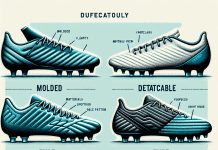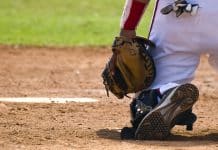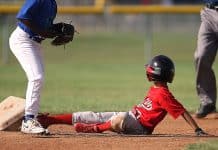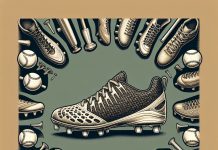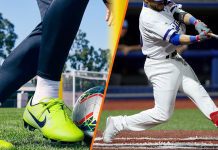Whether you are a passionate soccer player or a die-hard baseball fan, choosing the right footwear can make a world of difference in your performance. But is there really a significant distinction between cleats designed for different sports? From the grip on the field to the support and comfort provided, this article explores the variations in cleats for various athletic activities. So, lace up your shoes and get ready to discover how the right pair of cleats can elevate your game to new heights.
Types of Cleats
Review contents
Soccer Cleats
Soccer cleats, also known as football boots, are specifically designed for the game of soccer. They typically have low profiles and feature studs or cleats on the outsole to provide traction on natural grass. The upper material is usually made of a combination of synthetic materials and leather, providing durability and flexibility for quick movements on the field. Soccer cleats also often have a unique lacing system that helps to secure the foot and provide a snug fit for optimal control and maneuverability.
Football Cleats
Football cleats, also called football boots or cleats, are designed for American football. They are similar in many ways to soccer cleats, with the main difference being the additional ankle support they provide. Football cleats typically have a higher-cut design to protect the ankle from potential injuries during contact plays. The studs on the outsole of football cleats are also designed to provide traction on natural grass, allowing players to make quick cuts and changes in direction.
Baseball Cleats
Baseball cleats are specifically designed for the game of baseball. They feature a low-cut design similar to soccer cleats, but with a different type of stud on the outsole. Baseball cleats have metal spikes or molded rubber studs that provide excellent traction on both grass and dirt surfaces. The upper material of baseball cleats is usually made of synthetic materials or leather to provide durability and flexibility. Some baseball cleats also come with additional toe protection to guard against abrasion and impacts.
Basketball Shoes
Basketball shoes are specialized footwear designed for the sport of basketball. Unlike cleats, basketball shoes don’t have studs or cleats on the outsole. Instead, they have a flat and textured outsole that provides grip and traction on indoor courts. Basketball shoes usually feature a high-top design to provide ankle support during quick changes in direction and jumps. The upper material is often made of a combination of synthetic and breathable materials to provide comfort and support for the foot.
Golf Shoes
Golf shoes are specifically designed for the sport of golf, where players spend long hours on the course walking and swinging a golf club. Golf shoes have a low-profile design and often feature spiked soles that provide excellent traction on grass and prevent slipping during the swing. The upper material of golf shoes is typically made of leather or synthetic materials, providing stability and waterproofing to keep the feet dry during wet conditions on the course.
Track Spikes
Track spikes are lightweight athletic footwear designed for track and field events. They are characterized by their sharp metal or plastic spikes on the outsole, which provide maximum traction on the track surface. Track spikes come in different variations depending on the event, including sprint spikes, middle-distance spikes, and long-distance spikes. They have a minimalistic design to reduce weight and improve speed. The upper material of track spikes is generally lightweight and breathable to enhance performance and minimize discomfort during races.
Cycling Shoes
Cycling shoes are specialized footwear designed for cycling, whether it be road cycling, mountain biking, or indoor cycling. They are characterized by their stiff soles, which provide efficient power transfer from the foot to the pedal. Cycling shoes often feature a clipless pedal system, where cleats on the outsole of the shoe attach to the pedals, allowing the rider to pedal more efficiently. The upper material of cycling shoes is typically made of synthetic materials and is designed to be lightweight, breathable, and supportive.
Tennis Shoes
Tennis shoes, also known as court shoes, are designed specifically for the sport of tennis. They have a flat and low-to-the-ground sole that provides stability and quick lateral movements on hard court surfaces. Tennis shoes often have reinforced toe caps and sturdy outsoles to withstand the repetitive movements and impacts that occur during tennis matches. The upper material is typically made of durable and breathable materials, providing support and comfort during long hours of play.
Rugby Boots
Rugby boots, also known as cleats, are designed for the physical and demanding sport of rugby. They are similar in design to soccer cleats, with a low-profile silhouette and studs on the outsole for traction on natural grass. However, rugby boots often have a more robust construction to withstand the intense physical contact and scrums that occur in the game. The upper material of rugby boots is typically made of durable leather or synthetic materials to provide support and protection.
Volleyball Shoes
Volleyball shoes are specialized footwear designed for the sport of volleyball. They have a lightweight and flexible design that allows for quick lateral movements and jumps. Volleyball shoes often have a gum rubber outsole that provides excellent traction on indoor court surfaces. The upper material is typically made of breathable and durable materials that offer support and stability to the foot during jumps and rapid changes in direction.
Surface Compatibility
Natural Grass
Different sports often require different types of cleats depending on the playing surface. For sports played on natural grass surfaces, like soccer and football, cleats with studs or cleats on the outsole are essential to provide traction and prevent slipping. The stud configuration and length can vary depending on the sport and specific playing conditions, such as wet or dry grass.
Artificial Turf
Artificial turf surfaces, commonly found in football and soccer fields, require cleats that are specifically designed for this type of surface. These cleats often have shorter and more numerous studs or a patterned outsole to provide the necessary traction without causing damage to the turf. It is important to choose cleats that are explicitly labeled for use on artificial turf to maintain the durability and integrity of the playing surface.
Indoor Surfaces
Indoor sports, such as basketball and volleyball, are typically played on hardwood or synthetic court surfaces. Specialized shoes designed for these indoor surfaces have non-marking rubber outsoles that provide grip and traction without damaging the flooring. The soles of indoor shoes are often flat and feature patterns or grooves that enhance multidirectional movements on the court.
Hard Court Surfaces
Sports like tennis and basketball are often played on hard court surfaces, such as concrete or asphalt. Cleats are not typically used for these sports, but rather shoes that are specifically designed for hard court surfaces. Tennis shoes and basketball shoes usually have durable outsoles that are resistant to abrasion, providing excellent grip and traction on these hard surfaces.
Soft Ground
Some sports, like rugby and football, may be played on soft or muddy grounds. For these conditions, cleats with longer studs or metal spikes are often used to provide the necessary traction and prevent players from sinking into the ground. The stud configuration can vary depending on the sport and playing conditions, allowing players to adapt to the varying levels of softness and grip required on different surfaces.







